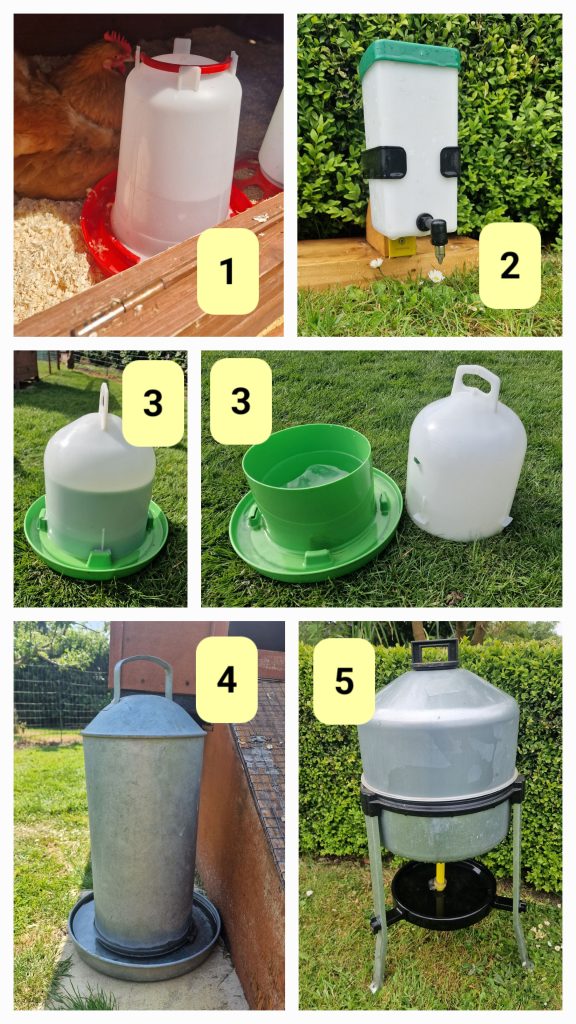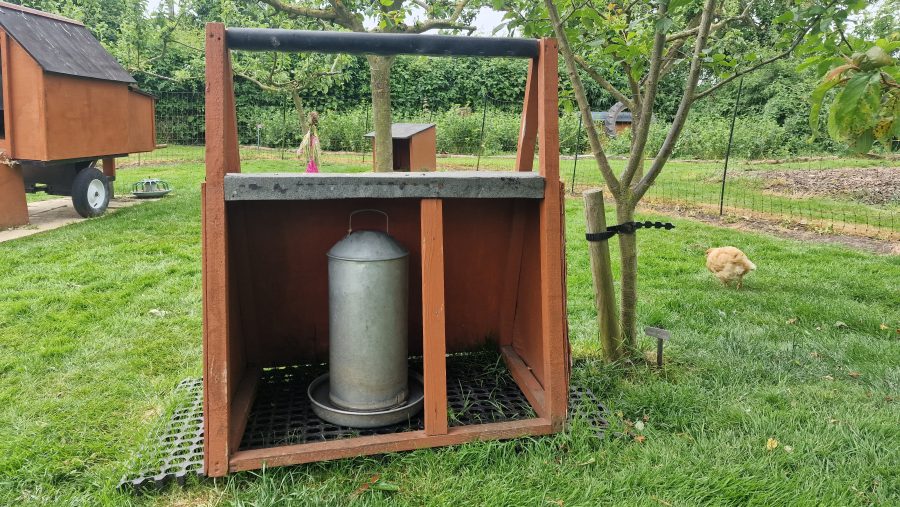Hot, dry summer days bring a new set of challenges when providing water for your poultry. In this article extract taken from Practical Poultry in the August issue of The Country Smallholder magazine, Fiona and Hugh Osborne describe how they have solved some of these issues.
Hot summer days have meant we have had to carefully think about the drinkers we deploy in the chicken enclosure. There are many different drinkers available on the market. The type we choose is dependent on what we want to do with them. For example, when we have young chicks in the flock, high tripod drinkers are not appropriate and in summer, we have many different ages of chickens from day olds to adults.
 The photograph (right) shows some of the different types, but let’s go through some of the advantages and disadvantages so you can choose the right drinker:
The photograph (right) shows some of the different types, but let’s go through some of the advantages and disadvantages so you can choose the right drinker:
1.This is a 1.5L plastic drinker that has a small capacity so isn’t very suitable for adult hens but it’s a great size for our chicks as a first drinker. We ensure all of our chicks have access to a drinker inside the coop on hatch although, don’t panic if you don’t do this. They don’t need water until 24-48 hours after hatching as they continue to be sustained by the remainder of the yolk from the egg for that period.
2.This is a nipple drinker which again is a great drinker for chicks and can be used for adults but a large capacity reservoir would be advisable.
3.This is a drinker that we love. It’s sustainable as it’s not oil based plastic but made from plant products. It has an internal reservoir so is easy to fill. Not suitable for chicks, but great for point of lay and adult chickens.
4. A galvanised drinker has great longevity. Plastic can degrade over time in the sunlight and is more likely to generate algae as they let sunlight in but galvanised drinkers will last much longer. The downside is that if you choose to add cider vinegar to the water to support gut health, the acid will react with the zinc coating on the steel which will leech from the drinker and can be toxic.
5.Tripod drinker. This is the drinker that we use in Winter. Due to the height of the drinker, we don’t utilise this in Summer. As breeders during the warmer Summer months, we have multiple ages.
Although we don’t have them, automatic drinkers are available. These are connected to the water supply (usually a large reservoir) and will replenish the levels as soon as your chickens consume water, much like an automatic horse trough on a smaller scale. Nipple drinkers can be purchased in this format too, rather than being connected to a refillable reservoir. These are most suitable if you have large numbers of chickens. Our maximum number (most of which will be very young chickens) is under 100, so we have never seen this as necessary for us but they are worth thinking about for larger flocks.
AVAILABILITY
In the heat of summer, easy access to water is essential as your flock will take in more water. In our group we have many different ages of chickens from a few days old to a few years old and there is a very definite pecking order. The youngest have the protection of their brood hen and the oldest have the status high in the pecking order, but there is a group in the middle who may find it more difficult to access water if the only water available is guarded by the older hens. As a result, we have multiple drinkers dotted around the orchard where the chickens live. It generally means that at least one drinker is available for the younger chickens to quench their thirst.
This article extract was taken from the August edition of The Country Smallholder. To read the article in full, you can buy the issue here.
To receive regular copies of The Country Smallholder magazine featuring more articles like this, subscribe here.
For FREE updates from the world of smallholding, sign up for The Country Smallholder newsletter here.








